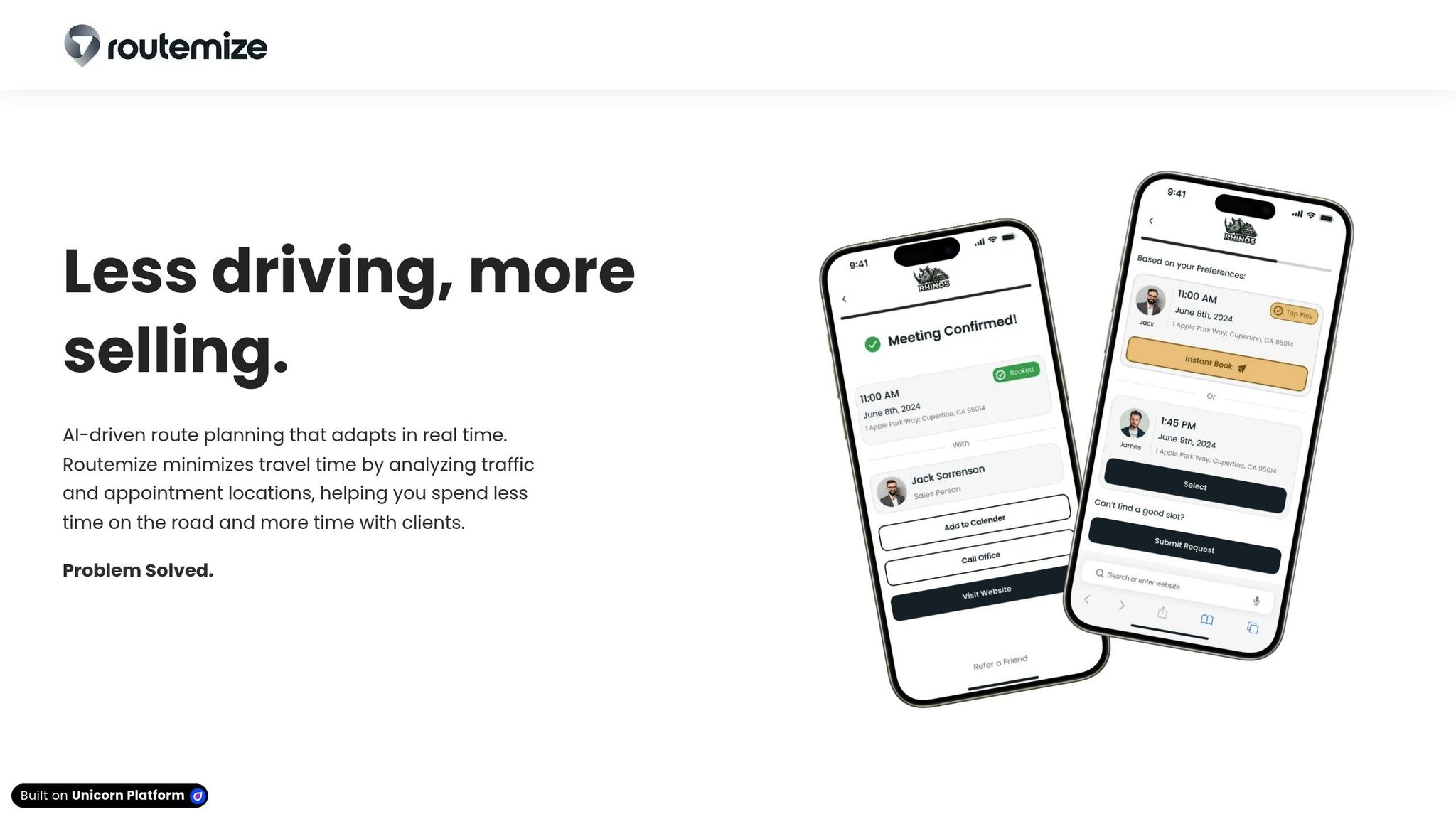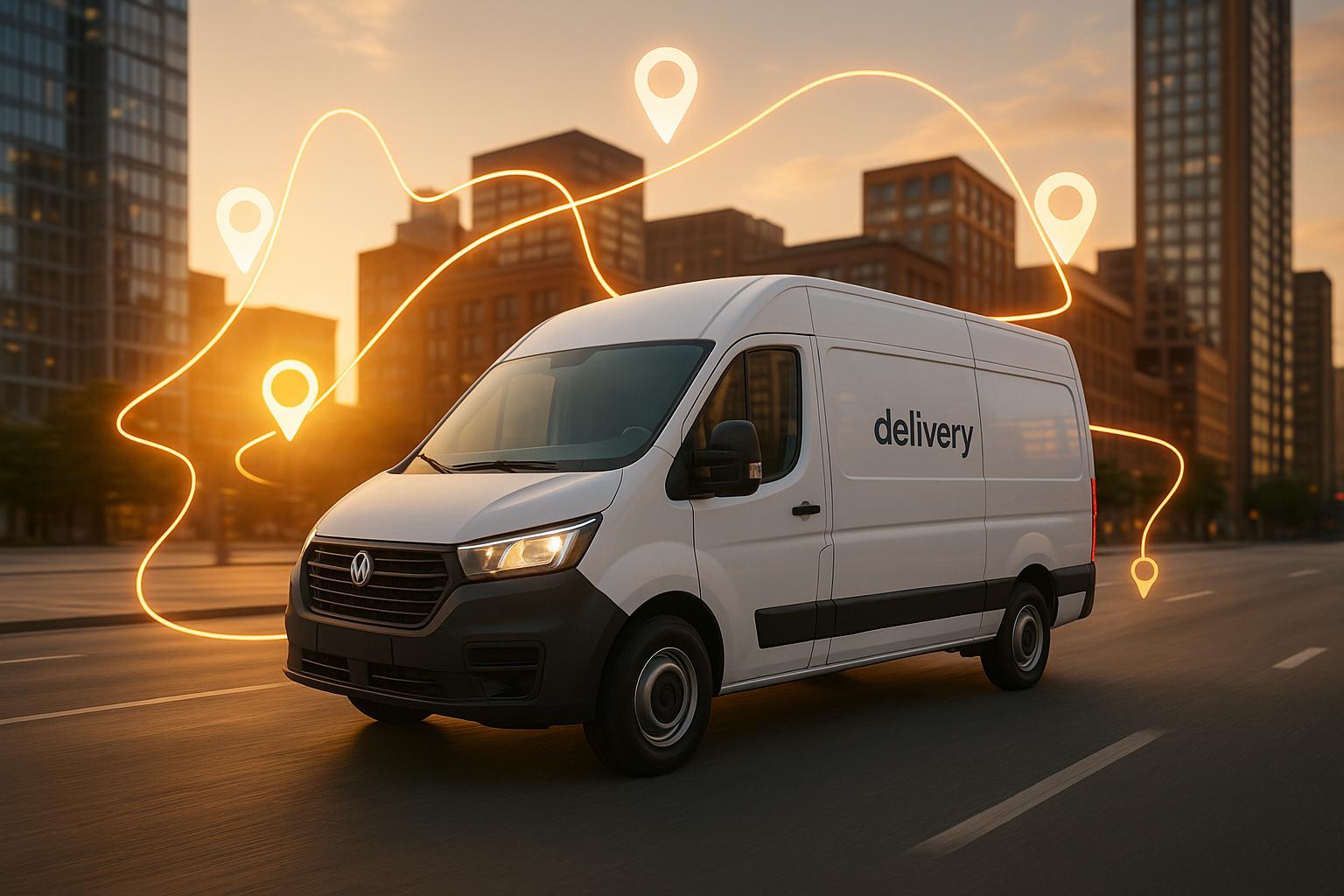Fuel costs are a major expense for delivery fleets, making up 24% of operating costs. Smart routing solutions can reduce fuel use, save money, and improve efficiency. Here’s how:
- AI-Powered Route Planning: Tools like Routemize optimize routes, cutting idle time and fuel use by up to 25%.
- Live Traffic Monitoring: Avoid congestion and save up to 6 billion gallons of fuel annually.
- Auto-Adjusting Routes: Dynamically adapt to real-time traffic and weather for 3–9% fuel savings.
- Cargo Weight Distribution: Properly balanced loads can cut fuel use by 7%.
- Multi-Stop Route Planners: Reduce delivery costs by up to 20% with optimized routes.
- Vehicle Maintenance Tracking: Regular care can improve fuel efficiency by up to 40%.
- Driver Performance Tracking: Monitor habits like idling and speeding to save fuel.
- Weather-Smart Planning: Avoid weather-related inefficiencies and save up to 10% on fuel.
Quick Comparison
| Strategy | Potential Savings | Key Features |
|---|---|---|
| AI Route Planning | Up to 25% | Real-time traffic, vehicle capacity analysis |
| Live Traffic Monitoring | Up to 6B gallons | Avoids jams, integrates with fleet systems |
| Auto-Adjusting Routes | 3–9% | Adapts to traffic, weather, and road quality |
| Cargo Weight Distribution | 7% | Balances loads for better fuel efficiency |
| Multi-Stop Route Planners | 20% | Optimizes complex delivery schedules |
| Vehicle Maintenance Tracking | Up to 40% | Tracks tune-ups, tire pressure, and repairs |
| Driver Performance Tracking | 10–40% | Monitors idling, speeding, and harsh braking |
| Weather-Smart Planning | 10% | Adjusts for storms, wind, rain, and heat |
These strategies, when combined, can transform delivery operations, cut costs, and boost efficiency. Start implementing them today to see immediate savings.
Unlock the Power of Logistics with BIG-AI: Route Optimization & Cost Reduction
1. Routemize: AI-Powered Route Planning

Routemize uses AI to optimize routes in ways that go beyond standard GPS tools, helping businesses cut fuel costs. By analyzing real-time traffic, delivery schedules, and vehicle details, the platform creates routes designed to reduce idle time and unnecessary mileage. This advanced approach seamlessly integrates with existing fleet management systems through API connections, making it easy to improve route efficiency without disrupting current operations.
The platform’s AI engine takes into account factors like vehicle capacity, type, customer preferences, traffic conditions, and even weather. When implemented effectively, this can lower delivery costs by up to 25%. For context, idling for just 10 seconds wastes more fuel than restarting the engine.
What sets Routemize apart is its ability to handle complex, multi-stop routes. Using its Engine API, the system sequences deliveries by considering variables like time windows, driver schedules, and start/end points.
Here’s a quick comparison of how Routemize impacts operational metrics:
| Metric | Traditional Planning | With AI Optimization |
|---|---|---|
| Planning Time | Manual calculation | Up to 38% faster |
| Route Efficiency | Fixed routes | Dynamically adjusts |
| Fuel Usage | Standard consumption | Up to 25% reduction |
| Traffic Response | Reactive | Predictive analytics |
To get the most out of Routemize, follow these steps:
- Input accurate vehicle details, including capacity.
- Regularly update delivery windows and priority levels.
- Use real-time traffic monitoring.
- Track route compliance and performance data.
- Adjust settings based on performance insights.
2. Live Traffic Monitoring Systems
Live traffic monitoring takes fuel-saving efforts to the next level by guiding drivers away from traffic jams and reducing idle time. Studies reveal that vehicles waste about 6 billion gallons of fuel annually sitting at traffic lights or stuck in heavy traffic. This issue is even more pronounced for heavy trucks, which burn far more fuel than passenger cars while idling.
Modern systems combine data from multiple sources to create smarter routes. For example, the Oak Ridge National Laboratory (ORNL) developed a system using GRIDSMART stop-light cameras and AI technology to monitor vehicles and evaluate fuel efficiency. In tests involving heavy truck traffic, this system showed potential fuel savings of up to 25%.
Popular Traffic Monitoring Apps
Here's a quick look at some top-rated apps that help drivers plan fuel-efficient routes:
| App | Key Features | Best For | User Rating |
|---|---|---|---|
| Waze | Crowdsourced data, real-time alerts | Daily drivers | 4.8/5 (iOS) |
| Traffic Spotter | Traffic flow, incident reports | Route planning | 4.4/5 (Android) |
| Traffic Maps | Advance warnings, alternate routes | Multi-stop trips | 4.7/5 (iOS) |
Tips for Maximizing Fuel Savings
- Integrate with Fleet Management: Link real-time traffic data to your fleet management software through APIs to enable dynamic route changes.
- User-Friendly Driver Displays: Equip drivers with intuitive interfaces for quick updates.
- Analyze Traffic Patterns: Use traffic data to identify routes with frequent congestion and plan around peak hours.
Combining these strategies with your fleet's existing tools can significantly improve route efficiency.
"This study gives us ideas for how our system could be used in the future for more than just reducing congestion. It could actually save energy and help the environment." - Tim Gee, principal computer vision engineer at GRIDSMART
Real-Time Solutions in Action
LiveViewGPS showcases how modern systems merge web-based GPS tracking with Google Maps live traffic updates. This approach allows fleet managers to make real-time decisions that cut idle time and fuel waste.
Set up your system to notify drivers about congestion, accidents, or closures that could impact fuel use. This way, drivers can adjust their routes on the go and avoid wasting fuel while idling.
3. Auto-Adjusting Route Systems
Auto-adjusting route systems rely on real-time data to dynamically optimize routes, cutting fuel consumption across networks by 3.3% to 9.3% compared to older, time-based routing methods.
How Auto-Adjusting Systems Work
These advanced tools evaluate multiple factors at once to find the most fuel-efficient route. Unlike standard GPS systems that prioritize distance alone, these systems take into account:
- Real-time traffic updates
- Weather conditions
- Vehicle performance metrics
- Road inclines and surface quality
- Delivery requirements
- Fuel usage trends
By analyzing these variables, companies can achieve measurable improvements in efficiency across different sectors.
Real-World Impact
Industries adopting auto-adjusting systems have seen impressive outcomes. For instance, FarEye’s routing engine processes 4,000 orders in just 8 minutes. Their tools have helped businesses significantly lower costs:
| Industry | Results | Key Benefits |
|---|---|---|
| Courier Services | 20% drop in delivery expenses | Better delivery zone precision |
| Food Delivery | 46% cost reduction | 90% increase in operational scale |
| Trucking | Over $1M saved annually | 90% less planning time |
These systems not only reduce costs but also adapt to variables like weather and traffic, making them even more effective.
Weather and Traffic Considerations
Weather delays cost trucking companies about $3.5 billion every year. Auto-adjusting systems help minimize these losses by:
- Incorporating weather forecasts into route planning
- Offering alternate routes during bad weather
"Real-time route adjustments are crucial for logistics companies to navigate the unpredictable nature of traffic and weather conditions." - Tayyab Javed, TechTidbits Times
Implementation Success Story
Leading logistics firms have reported major fuel savings after adopting auto-adjusting technologies, showcasing their ability to lower operational costs while addressing environmental concerns.
Maximizing System Effectiveness
To get the most out of these systems, businesses should:
- Integrate them with existing tools like ERP, TMS, or WMS platforms.
- Train drivers thoroughly to ensure proper use.
- Leverage diverse data sources, including traffic reports, weather updates, and vehicle telematics.
- Continuously monitor system performance to refine routing strategies.
In urban areas, where drivers lose an average of 119 hours annually in traffic, these systems shine. They help avoid congestion, adapt to changing conditions, and keep operations running smoothly - all while slashing fuel expenses.
4. Cargo Weight Distribution Tools
Managing cargo load effectively is just as important as route optimization when it comes to fuel efficiency. Tools designed for weight distribution can help lower fuel costs by improving how loads are planned. Research indicates that reducing a vehicle's weight by 10% can cut fuel consumption by around 7% and lower greenhouse gas emissions by up to 4%.
Advanced Load Planning Software
Weight distribution software plays a key role in improving fuel efficiency. Here are two popular tools:
| Software | Key Features | Pricing |
|---|---|---|
| LoadCargo.in | - Automatic planning - 3D interactive views - Excel data import |
From $30/month to $580 lifetime |
| EasyCargo | - Spread My Cargo feature - Daily planning options - Real-time adjustments |
From $4.80 per day |
Using these tools alongside efficient routing strategies can significantly reduce fuel consumption.
Weight Distribution Best Practices
- Regular Vehicle Audits Periodically inspect vehicles to remove unnecessary items that add weight. For example, every gallon of diesel adds roughly 7 pounds to a vehicle's total weight.
-
Equipment Optimization
Replace heavier materials with lighter alternatives to minimize overall weight:
- Switch from steel to aluminum shelving
- Use composite storage bins
- Opt for lightweight racking systems
-
Load Distribution Monitoring
Keep track of weight distribution to ensure stability and safety by using:
- Onboard weighing systems
- Manual scale checks
- Visual inspections
"Proper truck weight distribution is crucial for safe and efficient driving. Imbalanced loads can cause instability, increase wear and tear, and pose safety risks on the road." - Tata Motors
Implementation Guidelines
To achieve the best results:
- Distribute cargo evenly across axles
- Secure items with appropriate tie-downs
- Factor in axle configuration when placing loads
- Maintain correct tire pressure
- Integrate data with your existing business systems for smoother operations
sbb-itb-7020db0
5. Multiple Stop Route Planners
Multiple stop route planners help businesses lower fuel expenses and simplify complex delivery schedules. By using advanced technology, these tools make it easier to manage routes with multiple stops effectively.
Research indicates that well-optimized multi-stop route planning can reduce delivery costs by as much as 20%. Here's a look at two popular solutions:
| Solution | Key Features | Cost Savings | Results |
|---|---|---|---|
| Routific | - AI-powered optimization - Traffic pattern analysis - Driver preference integration |
25% reduction in delivery costs | Dynamic routing improvements |
| Beans Route | - Apartment-specific routing - Advanced optimization - Location note-taking |
20% reduction in route completion time | 72% increase in stops per hour |
Features That Improve Fuel Efficiency
- Dynamic Route Adjustment: These tools monitor traffic in real time and automatically reroute drivers to avoid delays.
- Custom Vehicle Settings: They allow customization based on vehicle specifications, load capacity, and fuel consumption patterns.
Industry Challenges and Solutions
Transportation inefficiencies in the U.S. cost about $95 billion annually. Route planners tackle these issues by:
- Using GPS to optimize routes and reduce fuel use by up to 20%.
- Incorporating real-time traffic data to avoid congestion.
- Reducing idle time and preventing empty backhauls.
"A multi-stop route planner reduces the complexity involved in managing routes with numerous stops, ultimately streamlining operations." - FarEye
Tips for Successful Implementation
To maximize the benefits of these planners, integrate them with your current fleet management systems. Look for features like:
- Real-time traffic and weather updates.
- Dynamic rerouting options.
- Predictive analytics for better route planning.
- Compatibility with existing business tools.
For optimal results, combine these systems with proper driver training and regular software updates.
6. Vehicle Maintenance Tracking
Keeping vehicles in good condition isn’t just about avoiding breakdowns – it’s a key way to reduce fuel use through preventive care and timely repairs.
Impact on Fuel Economy
Regular maintenance can lead to noticeable fuel savings. Here’s how different tasks contribute:
| Maintenance Task | Potential Fuel Savings | What to Do |
|---|---|---|
| Engine Tune-up | Up to 4% | Follow the manufacturer’s recommendations |
| Tire Maintenance | Up to 3% | Check pressure and alignment monthly |
| Oil Changes | Up to 4% | Stick to the manufacturer’s intervals |
| Air Filter Replacement | Up to 10% | Replace when dirty |
| Oxygen Sensor Repair | Up to 40% | Fix immediately if faulty |
Modern Tracking Solutions
Today’s maintenance tracking platforms make it easier to stay on top of vehicle care, whether for a fleet or a single car.
Fleetio, for example, simplifies fleet maintenance. Samantha Saysoff, a fleet manager in Wyandotte County, shares: "With Fleetio's dashboard, everything is at the surface – I can create custom reports in under 5 minutes now, there's no having to dig for the information you're looking for".
For individual car owners, apps like these are highly rated:
- CarFAX Car Care: A popular choice for tracking maintenance.
- FIXD: Offers fault code explanations and repair estimates.
- Drivvo: Known for its user-friendly interface, with a 4.6-star rating and over 1.5 million downloads.
These tools don’t just track maintenance – they also highlight performance metrics that can help improve fuel efficiency.
Key Maintenance Factors to Watch
Pay attention to these areas to get the best fuel economy:
- Engine Performance: Using the right motor oil grade helps your engine run efficiently.
- Spark Plug Condition: Faulty spark plugs can reduce gas mileage by up to 30%.
- Air Filter Status: A clogged air filter can hurt fuel efficiency, so regular checks are important.
"When your vehicle is properly serviced, all its components function harmoniously, allowing for smoother operation and reduced fuel consumption." – Rio Grande Automotive
The City of Cambridge shows how effective maintenance tracking can cut costs. Tom Rowlings explains: "We never had any way to calculate vehicle downtime, or even return on investment, or overall cost of doing business. There was never a way to capture that prior to Fleetio".
7. Driver Performance Tracking
Driver behavior plays a major role in fuel use. Tracking systems help identify and address inefficient habits, cutting unnecessary costs.
Impact of Driving Habits
Driving style directly affects fuel efficiency. Aggressive driving can lower gas mileage by 15–30% on highways and 10–40% in stop-and-go traffic. Plus, every 5 mph over 50 mph adds about $0.27 per gallon to fuel costs.
"When you drive aggressively, it forces the engine to work harder. Aggressive acceleration and braking waste fuel." - Eric Riddles, ASE Certified Master Automobile Technician
Real-World Success Stories
Tracking driver performance has delivered measurable results for companies:
| Company | Action Taken | Results |
|---|---|---|
| Orkin | Tracked idle time through competition | 8.4% reduction in idling; $50,000 saved in 3 months |
| Wiseway | Monitored idle hours | 44% drop in idling and CO₂ emissions |
| Vitafoam | Added harsh braking alerts | Noticeable decrease in fuel consumption |
"Using the analytics feature has been helpful as I can now monitor harsh braking and acceleration, setting alarms to notify me. This not only improves driver safety but also reduces unnecessary fuel use!" - Dave Leigh, Transport Manager at Vitafoam
Key Behaviors to Monitor
Paying attention to certain driving behaviors can lead to significant savings:
- Idling Management: Idling for an hour can burn up to 0.8 gallons per truck. If 25 trucks idle for two hours daily, that’s 40 gallons wasted - adding up to $38,400 over 300 days.
- Speed Control: Keeping speeds below 50 mph helps maximize fuel efficiency.
- Acceleration and Braking: In-cab alerts notify drivers of:
- Harsh braking
- Rapid acceleration
- Sharp cornering
Performance Optimization Tools
Driver monitoring platforms are essential for improving habits and cutting costs. Here are a few options:
| Platform | Key Features | Mobile Access |
|---|---|---|
| SafetyCulture | Driver scoring; Free version | Yes |
| Samsara | Real-time tracking; Event recording | Yes |
| Verizon Connect | Customizable reports; Fleet analytics | Yes |
These tools give fleet managers the data they need to coach drivers effectively, reward efficient practices, and address problem areas. The result? Safer, more fuel-efficient driving across the board.
8. Weather-Smart Route Planning
Weather plays a big role in fuel efficiency. By using AI, fleet managers can make informed decisions to avoid weather conditions that increase fuel use. This method goes beyond regular dynamic routing by tackling weather-specific challenges.
How Weather Affects Fuel Use
Weather conditions can impact fuel consumption in different ways:
| Weather Condition | Fuel Impact | Suggested Action |
|---|---|---|
| Headwinds/Crosswinds | Up to 13% reduction per 10 mph | Adjust route to avoid strong winds |
| Temperature Drop | 2% more aerodynamic drag per 10°F drop | Avoid colder areas when possible |
| Rain | 0.2–0.3 mpg increase in fuel use | Choose drier routes |
| Hot Weather | 8–12% loss due to cooling fan use | Plan trips during cooler hours |
Using AI for Weather Prediction
AI-powered systems take weather routing to the next level by quickly analyzing large amounts of data. Nvidia's FourCastNet model, for example, processes weather forecasts in just 40 seconds, even on older hardware, allowing for quick route changes when conditions shift.
"If you have a model that's already trained, our FourCastNet model runs in 40 seconds on a junky old graphics card. So you could do like a whole gigantic ensemble that would not be feasible with physically based models."
– Mark DeMaria, atmospheric scientist at Colorado State University
Saving Money with Smarter Routes
Weather-smart routing can cut fuel use by up to 10% on routes prone to storms, save $30,000 for each Atlantic storm deviation, and reduce delays caused by weather.
Tips for Effective Weather Routing
- Use real-time weather data within navigation systems.
- Cross-check weather information from multiple reliable sources.
- Keep an eye on changing conditions to adjust routes quickly.
- Train drivers on how weather impacts fuel efficiency.
"Weather routing software is redefining how shipowners plan their voyages, delivering substantial cost savings and optimizing every nautical mile. By leveraging real-time weather data, AI algorithms, and vessel-specific parameters, this cutting-edge technology creates routes that are not only safer but also far more fuel-efficient."
– Ship Universe
Advanced Capabilities
Modern weather-smart systems handle enormous data inputs - NOAA collects 100 terabytes daily. This allows for accurate predictions on:
- Storm paths
- Wind shifts
- Temperature changes
- Rainfall intensity
Conclusion
Smart routing technologies are transforming how businesses manage fuel costs by using data to optimize routes and improve efficiency.
Savings You Can Expect
Smart routing methods can lead to fuel savings between 15% and 30%:
| Strategy | Potential Savings |
|---|---|
| Route Optimization Tools | Up to 15% |
| Telematics Systems | Up to 20% |
| Eco-driving Training | Up to 30% |
| Data-driven Operations | Up to 18% |
Steps to Implement Smart Routing
-
Evaluate Your Current System
Start by reviewing your existing routes and schedules. Identify inefficiencies, such as excessive idling, that waste fuel. -
Select the Right Tools
Invest in technology suited to your operations, combining route optimization software and fuel management systems. -
Track and Fine-Tune
Use telematics to gather performance data, then adjust routes to improve results and reduce costs.
Real-World Results
In 2022, AI-driven routing tools cut delays by 25% and increased on-time deliveries by 20%. Additionally, 68% of businesses reported lower annual energy costs.
"By planning delivery routes more efficiently, companies can shorten the distance that their vehicles must travel, which lowers fuel consumption and related expenses." – Locate2u
These tools and strategies are essential for creating a cost-effective, data-focused routing system. By following these steps, businesses can significantly reduce fuel expenses while improving overall efficiency.


